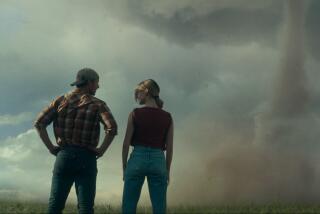Wanted for Test: A Tornado for Weather Forecasters
BOULDER, Colo. — Modern computer technology has been wedded with sophisticated new tools to create a storm-warning system here that will tell meteorologists what the weather is doing far overhead at the very moment it is doing it.
It was created to give the earliest warning possible of explosive weather systems like the tornado that destroyed Saragosa, Tex., on May 22, killing at least 29 people and injuring more than 100 others.
The new system is still in the experimental stage at the National Oceanic and Atmospheric Administration’s environmental research laboratories here, where chase crews are being sent out into the field in pursuit of foul weather to see if storms develop the way the data suggests.
The new tools include Doppler radar systems, called “profilers,” pointed nearly straight up that give instantaneous readings of which way and how fast the wind is blowing at every elevation up to 50,000 feet over northeastern Colorado. That information, coupled with computer terminals that overlay data from various sources to provide sort of a motion picture of high-level weather patterns, gives researchers in Boulder the best chance they have ever had to predict storms.
Nationwide System Planned
And although the system is still being tested and is not yet operational, parts of it will be expanded into a nationwide system over the next few years, and the heart of this program will be extended to cover the entire Tornado Belt through the central United States, which is ripped by more than 800 tornadoes each year.
“There’s no question we’ll get a big improvement in our forecasting,” said Sandy MacDonald, director of the program.
The system should allow forecasters to issue a warning at least 20 minutes before the tornado hits, giving residents more of an opportunity to take cover.
But even though the new system may be a giant leap forward in forecasting, success will still depend largely on the interpretation of the data by meteorologists who must find order in the chaotic weather patterns that can change dramatically in just a few minutes here, where the great Rocky Mountains plunge into the rich farmlands of eastern Colorado.
The best tools, MacDonald acknowledged, are no better than the men and women who use them.
“We’ve been doing this for almost 100 years, but it still comes down to a tough call,” he said as he sat behind an array of computer consoles.
That was demonstrated last week when The Times accompanied a chase crew in hot pursuit of storms that looked beautiful to researchers, but threatening to anyone else.
Flush With Excitement
The people of Boulder had awakened one recent morning to an uncommonly beautiful day for a season normally marked by fierce thunderstorms and occasional tornadoes. A few clouds hovered over the Rockies to the west, and more could be seen over the plains to the east, but overhead the sun was in full command.
But as he twisted the dials of a series of computers inside his laboratory here, MacDonald was flush with excitement.
“The ingredients for good storms are here today,” he said. It helps to remember that for a storm chaser, good weather is the kind of stuff that produces storms that send others running for cover.
MacDonald flipped one switch and a computer terminal turned into a movie screen, rapidly displaying satellite photos taken 30 minutes apart to re-create the past few hours, showing the movement of cloud systems over North America. He hit a switch and zoomed in to the area between Denver and the Wyoming border, and the clouds danced across the screen, showing that the winds above were anything but stable.
He hit another switch and the terminal displayed a series of short lines that looked a little like a badly worn, hand-woven rug. Each line on the screen represented the direction the wind was blowing at every elevation up to 50,000 feet. That “profiler” display was made possible by the newest tool in the program, Doppler radar antennas pointed nearly straight up. The profiler is one of two Doppler radar systems used in the program.
The Center for Atmospheric Research, a Boulder facility run by a consortium of 57 universities and research institutions, has experimented with Doppler radar of a more conventional sort for years. The Doppler effect, familiar to anyone who has listened to the change in pitch of a train whistle as it approaches and recedes, results from the change in the wavelength emitted by the moving object.
Sound waves from a moving train are compressed as the train approaches and stretched as the train recedes, thus altering the pitch. Radar waves do the same thing, and by measuring the change in wavelength, it is possible to determine if the object is moving closer or farther away, and how fast. The information is fed into a computer that measures the change and presents it automatically in a color-coded image of the area.
Measure of Moisture Content
Since radar waves are bounced back by moisture in the air, it is possible to track the movement of storms across the sky by the Doppler effect. The strength of the returned signal--called the reflectivity--also tells meteorologists how much moisture is in the storm, another critical component in predicting severe weather.
More than 100 Doppler radar systems are scheduled to be installed by the U.S. Weather Service over the next few years, including two in Southern California and one in Arizona, which will work in concert, helping meteorologists determine the exact location of storms by triangulation. The system will also tell them in which direction storms are moving and how fast.
But that type of system does not tell which way the winds are moving at various elevations directly overhead, a critical component in the Tornado Belt because meteorologists need to know whether winds are blowing in such a way as to “spin the storm,” possibly creating a tornado.
The Doppler radar used for the profilers here fills that gap.
“Look at that,” MacDonald said as he stared at the terminal. “We’ve got winds close to a hundred knots” at higher elevations.
Winds, however, are not enough to create tornadoes.
Tornadoes are born in thunderclouds that have enough moisture to generate the energy needed to fuel the system. And infrared satellite images told MacDonald of a long finger of dry weather extending along the eastern base of the Rockies.
If that dry zone absorbed the moisture that the storms would need to produce severe weather, there would be no tornadoes on that day.
“The question is, is that moisture going to be there?” MacDonald said. He quickly added, however, that the day looked very promising.
A few minutes later, in a weather briefing down the hall, other researchers had looked at the same data and reached the opposite conclusion.
The dry air would kill the day. There would be no severe storms in the Boulder area.
MacDonald, who has worked as a meteorologist, was sure his researchers were wrong, led astray by their lack of experience predicting weather in the field. He insisted that chase crews be sent out.
A short time later Fritz Kruse, a recent graduate of the University of Wisconsin, aimed his government car down the highway. Beside him sat Matt Einson, a graduate student in meteorology.
Impressive Bank of Cumulus
An impressive bank of cumulus clouds off in the distance caught his attention for a while, but he could tell by the smooth band across the center of the formation that the clouds were already producing rain.
“They’re going to rain themselves out,” he said, depriving the clouds of the moisture they would need to form a tornado.
The radio crackled continuously with chatter between the six chase cars, manned mostly by graduate students of meteorology, and the control room back at the laboratory, where researchers were monitoring the consoles and trying to figure out where to send the crews.
It took no more than an hour for MacDonald’s stock to rise. An ominous cloud bank over the Rockies suddenly turned greenish-black.
“The green color means there’s hail,” Einson said.
The radio came to life again with word that MacDonald’s wife had called him to say that the garden he had planted the weekend before had just been wiped out by hail.
It was a small price for a researcher to pay, and MacDonald was delighted.
“We’re picking up hail,” one of the chase cars reported. “It was at least the size of a marble, judging by the size of the bump on the top of my head.”
Kruse turned off on a side road and headed into the storm, hoping for similar success.
Within moments the road turned white with hail. He stopped, leaned out the door and picked up a hailstone that measured an inch in diameter.
The hail was an important sign to the chase cars because hail is formed when updrafts carry moisture high into the sky. At the colder temperatures it forms into hail and drops, but if the updrafts are strong enough, the hailstones are picked up again and sent back up for another coating of ice. The process repeats itself until the hail finally plunges to the ground.
The hailstones were large because they had been “bounced up and down” repeatedly, Einson said, thus proving that the clouds were being buffeted by severe updrafts, one of the critical components in the formation of a tornado.
The updrafts push the moisture--the storm system’s fuel--up, where crosswinds could give it the spin needed to give the system the cyclonic winds needed to generate a funnel.
The spinning would show up on the Doppler radar because one side of the funnel would be spinning toward the radar’s antenna and the opposite side would be spinning away. And the radar showed that as promising as the clouds had been, there was not enough spin to do the job. There would be no tornado from that system, and Kruse turned his car around and headed east across the plains.
‘Looking Nice Up Here’
“This is looking nice up here,” he radioed back to control as he sped toward a towering cloud structure that looked like a giant, white anvil, the form assumed by cumulus clouds when buffeted by strong updrafts.
“You mean ferocious,” Einson said.
Reflecting a moment on the way his statement sounded, Kruse turned to the reporter on the back seat and said, “It’s not that we want a tornado to occur. . . .”
Kruse got hooked on tornadoes as a young boy when his father first took him out to chase storms, a hobby he had picked up in college. He has been chasing storms ever since.
But this day was to prove a disappointment.
He watched in dismay as the cloud system slowly fell apart.
“It’s junk,” he said, remorsefully. “Junk, junk, junk.”
Later, back at the control room, the tired chase crews swapped stories about the storms they had seen.
It was not really a bad day, they concluded. At least they got some hail. Kruse was sure he had even seen a small funnel, the precursor to a tornado, although no one else had seen it.
Their 13-week exercise had just begun. Surely, some time in the next few weeks one of those clouds would send down a funnel that would whip itself into a fury.
With any luck, that funnel would eventually touch the ground and they would have their tornado.
And with a little more luck, they would be close enough to capture it on videotape, but far enough away to escape its wrath.
More to Read
Sign up for Essential California
The most important California stories and recommendations in your inbox every morning.
You may occasionally receive promotional content from the Los Angeles Times.










